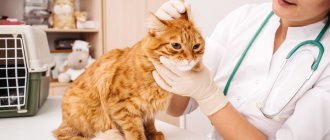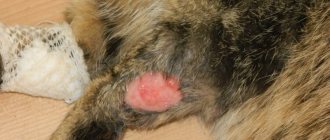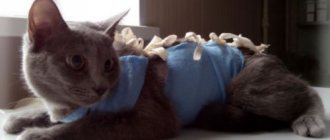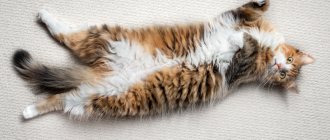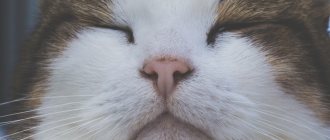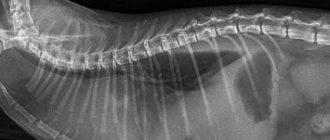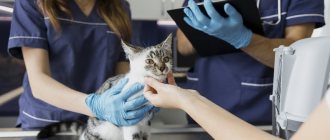If for a long time the owners notice that the cat has different pupils, they often suspect health problems. Depending on the symptoms, the cause may not only be an eye disease. A change in the cat's behavior and the obvious consequences of a blow as a result can lead to irreversible consequences if the size of the pupil is not monitored in time.
What is anisocoria?
In cats, the pupil is an elliptical hole in the middle of the iris that allows light to pass through the eyeball to the retina. The pupil constricts or dilates (enlarges) depending on the amount of light entering the eye, with both pupils typically dilating in dim light and constricting in bright light.
Anisocoria is a condition in which the two pupils of a cat's eye are different sizes.
; in other words, one pupil is larger than the other. In some cases, the abnormal pupil may be the one that is smaller, and in other cases, the abnormal pupil may be the one that is larger.
Associated symptoms
Pathologies develop over time and are accompanied by additional symptoms. If a cat has pupils of different sizes, it often reacts to light with only one eye. Intense tearing, redness or clouding of the cornea causes pain and discomfort. She may reflexively squint if there are problems in the functioning of the eyelids. If your cat has poor coordination of movements and is vomiting, poisoning from toxic plants or drugs is possible.
An active lifestyle puts a kitten in danger; you need to pay special attention to its behavior after a fight with other animals or falls from a height. Often a concussion is accompanied by loss of consciousness and, as a consequence, memory loss. Having woken up, the pet does not recognize the owner, hisses, behaves inappropriately, and tries to hide in hard-to-reach places. If the cat came from the street, and upon examination the owner noticed hematomas, bruises, bruises on the head or neck, redness of the mucous membranes or convulsions, it is necessary to urgently contact a veterinarian.
If with such a symptom the animal has become lethargic, then this is worth paying attention to.
Symptoms indicating a stroke deserve increased attention:
- unnatural head tilt; loss of balance; loss of appetite, lethargy, spontaneous bowel movements; paralysis of the paws on one side of the body; vomiting or epileptic seizure.
What causes anisocoria?
“Anisocoria occurs suddenly and you should seek veterinary attention immediately.”
Anisocoria is a symptom, and there can be several different causes, including:
- Corneal injuries, such as corneal ulcers
- Disease or damage to the brain or nerves leading to eye damage
- Glaucoma, a disease in which the pressure in the eyeball increases (the pupil in the affected eye will be dilated)
- Uveitis, or inflammation of the inside of the eye (the pupil in the affected eye will usually be narrowed)
- Retinal diseases
- Formation of scar tissue between the iris and lens (posterior synechia), a condition that can develop after uveitis
- Iris atrophy, or reduction in the amount of tissue in the iris, usually a degenerative change associated with aging
- A congenital iris defect in which the iris tissue does not develop properly
- Eye cancer
- Spasmodic pupil syndrome is a syndrome that may be associated with infection with feline leukemia virus.
If anisocoria occurs suddenly, you should treat it as an emergency and seek veterinary care immediately to reduce the chance that your cat's vision will be permanently lost.
Treatment
For treatment, the animal may be prescribed medications, but the possibility of surgical intervention cannot be ruled out. Therapy depends on the type and cause of the pathology.
Most often, drug therapy is prescribed to animals with infectious lesions. After suppressing the inflammatory process, the position of the eyeballs returns to normal. All medications, their dosage, duration of treatment are prescribed by a doctor.
Operation
Surgery is performed when drug therapy cannot eliminate the cause of strabismus, for example, if there is a tumor or damage to the eye muscles.
If surgery is recommended for your animal, the procedure should not be delayed. The sooner the surgery is performed, the higher the chance of treatment success.
At home
If the cat is prescribed drug therapy, treatment can be carried out at home. The owner can care for the animal. Your cat may need:
- rubbing the eyes;
- taking pills;
- use of painkillers.
If the doctor has prescribed IVs or injections, it is not necessary to hospitalize the cat. Many veterinary clinics offer home visits.
Traditional methods
If the cat squints only in one eye, then you can try to correct the position of the visual organ with a bandage. The animal needs to close its healthy eye every day. The bandage is applied for several hours.
Traditional methods can be combined with traditional treatment. For example, when diagnosing inflammatory processes, you can make lotions that are prepared from chamomile decoction. Traditional medicine can help eliminate the pathology, but provided that there are no indications for surgical intervention.
Before using unconventional methods, you should consult your veterinarian.
How is the underlying cause of anisocoria diagnosed?
Your veterinarian will begin with a physical examination of your cat, including a detailed examination of the eye structures. Depending on these preliminary results, your veterinarian may perform additional, more specific testing. Your veterinarian ophthalmologist can measure tear production and intraocular pressure (pressure in the eyes) for each eye. The cornea may be stained with fluorescein dye to identify underlying corneal lesions or ulcers, and a conjunctival scraping or biopsy may be obtained and sent to a diagnostic laboratory for specialized testing. Blood tests may be performed to determine if the problem is due to a systemic disease such as feline leukemia.
In some cases, your veterinarian may recommend a referral to a specialized veterinary ophthalmologist for further diagnostic testing.
Symptoms of the disease
Alarming symptoms include the following anomalies:
- blurred vision;
- photophobia;
- double vision;
- migraine;
- fever;
- acute pain syndrome in the eyes;
- nausea, less often – vomiting;
- torticollis;
- partial loss of vision;
- decline in performance.
If one pupil is slightly larger than the other, then this abnormal condition is immediately visible. At first, the patient may not pay attention to such a cosmetic defect, but subsequent symptoms raise serious concerns for his vision.
If such discomfort prevails, it is necessary to urgently seek qualified help from an ophthalmologist. If we are talking about a childhood disease, then the difference in pupils is already a good reason to go to a specialist.
Good to know
- Anatomy of the liver in cats
- The structure and functions of the thyroid gland in cats
- Measuring blood pressure in cats before general anesthesia
- Current role of dexmedetomidine in clinical veterinary anesthesia and intensive care
- Dynamic testing of thyroid function in cats
- Gabapentin in cats and dogs (all pros and cons, indications, contraindications, doses, features of use, instructions for use)
- Information content of hematological and echocardiographic preoperative screening indicators
- Historical background on hyperthyroidism in cats
- Hyperthyroidism in older cats
- Cardiac hypertrophy in domestic cats
- Analysis of anamnestic data during preoperative examination of small domestic animals
- Study of anamnestic data in cats that require manipulation under general anesthesia
- Method for measuring blood pressure in cats
- ICD in cats (diagnosis and symptoms)
- Hyperthyroidism is suspected, but serum T4 concentration is normal
- Acute gastroenterocolitis in dogs (etiology, pathogenesis, diagnosis and treatment)
- Reducing mortality during anesthesia is an important task of veterinary anesthesiology
- Thrombosis in cats (general information, etiology, pathogenesis, clinical picture, diagnosis and treatment)
- Urolithiasis of small animals (etiology, pathogenesis, diagnosis and treatment)
- Congestive cardiomyopathy in cats (What is it? How to protect your pets)
- Gastrointestinal tract in dogs (anatomy and physiology)
- Levofloxacin in pets
- Concentrations of total and free thyroxine in cats (T4 hormone)
- Surgical treatment for hyperthyroidism in cats
- Treatment and prevention of urolithiasis in animals
- Urinary tract stones in cats and dogs (causes and mechanisms of formation)
- Liver lipidosis in domestic cats (symptoms and treatment)
- Performing laboratory tests in cats with hyperthyroidism
- Treatment of hepatolipidosis in domestic cats
- Pathogenesis and colloid theory of stone formation in urolithiasis
- What preparation is necessary for a cat to undergo general anesthesia?
- Causes of stone formation in dogs and cats
- Ondansetron for dogs (mechanism of action, blockade of serotonin receptors)
- Urolithiasis in Russia (urolithiasis). Scourge of modernity
- Acute gastroenteritis in dogs (pirchinas, pathogenesis, diagnosis and treatment)
- What function does the liver perform in the body of animals and humans?
- Misdiagnosis of hyperthyroidism based on falsely high serum total T4 (or free T4) concentration
- Drugs for the treatment of hypertension associated with hyperthyroidism in cats
- Primary Cardiomyopathy in Cats (History, Causes, Pathogenesis)
- Pharmacological treatment of cats with hyperthyroidism
- Endogenous hyperthyroidism in cats (causes, definition, characteristics)
- Monitoring during anesthesia in cats (Why is this necessary?)
- Methods of thoracic radiography in cats during pre-anesthesia diagnosis
- Preoperative assessment of the physiological status of the animal’s body
- The role of additional diagnostic methods before anesthesia in cats
- ECHO examination in cats before planned interventions using anesthesia
- Echocardiographic diagnosis of myocardial diseases in cats
- Carrying out electrocardiographic diagnostics in cats
- Why is etamzilat prescribed?
- Performing a physical examination during surgery in cats
- Physiology of the thyroid gland in domestic animals
- The role of cardiac evaluation as part of the preoperative workup in cats
- Description of the thyroid gland (history and functions)
- The role of animal examination and clinical examination during preoperative screening examination
- Information content of palpation of the thyroid gland in cats
- Use of the antibiotic cefotaxime
- Instructions for the use of propofol in dogs and cats and other animal species
- Prevalence of liver disease in cats
- Restrictive myocardial diseases in cats (definition, diagnosis and therapy)
- Heart murmurs in cats (How to interpret? Diagnostic value of this symptom?)
- Symptoms of urolithiasis in pets
- The state of internal organ systems in healthy dogs
- Radioactive iodine therapy for cats with hyperthyroidism
- Tiletamine and zolazepam are a drug for non-inhalation anesthesia in dogs and cats.
- What thyroid hormones circulate in the blood plasma of animals?
- Informativeness of determining thyroid-stimulating hormone in cats
- Ceftriaxone is a cephalosporin group of antibiotics
- Ultrasound technique of the thyroid gland in domestic cats
Why does my cat have round pupils?
Having explained the function of the pupils in response to light, which is completely natural and typical for most animals, it is important to note that pupil dilation can also be due to other factors. So the answers to why your cat's pupils are dilated are numerous and may relate to situations or reactions to health problems. Focusing on these reasons associated with emotions and feelings, the cat’s round pupils express:
- Excitement: When an animal is very excited and nervous, such as during a play session, it is common to see round or elliptical pupils. However, excitement does not always occur due to positive stimuli, as it can also occur due to stress or anxiety.
- Satisfaction: In situations that create happiness, the cat will also dilate its pupils as a reflex. An example would be when we fill a food bowl.
- Fear: The cat has dilated pupils and eyes wide open. This is a clear sign of fear, which can be caused by change, loud noise, situation, etc.
- Aggression: Cats dilate their pupils when they look at their prey and prepare to attack, so if you look at yours in this way, you will feel threatened and consider defending yourself.
While some reasons for why a cat has round pupils are positive, it is important to note that this is not the usual way. In any case, dilatation indicates that the animal is not relaxed, and if it is due to him playing, we should not worry. But if we see dilated pupils most of the day, we should start to think that our cat is not healthy. It is possible that the animal is stressed by something and does not feel comfortable or safe, and it is our duty to find the reason that prevents it from restoring emotional stability.
On the other hand, it is important to emphasize that every cat is a world and can develop its own forms of communication, so dilated pupils are not always a reason for warning. By this we do not mean that we should not attach due importance to this, but it is important to know our cat, his character, behavior and reactions in order to learn how to identify the warning signal. Likewise, there are cat breeds with a predisposition to display elliptical or dilated pupils without causing an underlying problem, such as the British Shorthair.
Особенности аномалии в детском возрасте
РЈ детей анизокория SЂР°Р·РІРІРІРІР°РµС‚СЃСЏ РІ SЂРµР·СѓР»СЊС‚ате РЅР°СЃР»РµРґС ЃС‚венных РїСЂРёС‡РеРЅ или РЅРѕСЃРёС‚ РїСЂРёРѕР ±СЂРµС‚РµРСный характер РІ случае травм Рё инфекций органРѕРІ Р·СЂРµРСРёСЏ. Если РѕРґРёРЅ зрачок больше РґСЂСѓРіРѕРіРѕ Sѓ SЂРµР±РµРЅРєР° Рё RїСЂРё этом Р·СЂР µРЅРёРµ становвится хуже, Сѓ СЂРѕРґРёС‚ елей есть RїРѕРІРѕРґ для беспокойства. РЈ маленького ребенка непропорциональное расширенРёРµ зрачков обычно РїСЂРѕС…РѕРґРёС‚. Р' некоторых случаях асимметрия остается, РЅРѕ РЅРµ РїСЂРёС ‡РёРЅСЏРµС‚ ребенку дискомфорта Рё РЅРµ влияет РЅР° Р·СЂРµРСРеРµ. РўРѕРіРґР° SЂРµС‡СЊ Редет Рѕ наследственной физРеологическоой Р °РЅРѕРјР°Р»РёРё, РЅРµ несущей опасности для детского организма.
RљРѕРіРґР° ребенок рождается СЃ нормальными зрачками, РѕРЅР е РїСЂРѕРїРѕСЂС†Реонально SЂР°СЃС€РёСЂСЏСЋС‚СЃСЏ РїСЂРё люб РѕРј освещении, РЅРѕ внезапно RїСЂРѕСЏРІР»СЏРµС‚СЃСЏ R°РЅРёР·РѕРєРѕСЂРёСЏ, Рє врачу нужно обратиться немедленно. РџСЂРёС‡РеРЅС‹ такой аномалии РіРѕРІРѕСЂСЏС‚ Рѕ серьезных заболева РЅРёСЏС... (менРеРЅРіРёС‚, СОнцефаД РёС‚, аневризма, опухоль).
Основные причины аснмметрии зрачков у маленького ребенка:
- наследственная предрасположенность; действРеРµ Ренфекции или S‚равма глаз; врожденные особенности радужки; реакцна сотрясения РјРѕР·РіР° РѕС‚ удара; СЃ опущением век – СЃРёРЅРґСЂРѕРј Горнера; SЃРёРЅРґСЂРѕРј РР№РґРё СЃ отсутствнем SЂРµР°РєС†РёРё РЅР° SЃРІРµС‚; RјРµРґРёС†РеРЅСЃРєРёРµ RѕРїРµСЂР°С†РеРё РЅР° RѕСЂРіР°РЅР°С… R·СЂРµРЅРёСЏ.
RЎРёРЅРґСЂРѕРј Горнера Сѓ ребенка
Если РѕРґРёРЅ зрачок большой, Р° РґСЂСѓРіРѕРѕР№ – RјР°Р»РµРЅСЊРєРёР№, Рё РїСЂРё этоРј анизокория SЃРѕРїСЂРѕРІРѕР¶РґР°РµС ‚СЃСЏ раздвоением РІ глазах, головными болями, светобояР·РЅСЊСЋ, затуманенностью R ·СЂРµРЅРѕЏ, – это следствве некоторого патологическРѕРіРѕ процесса. Чтобы РЅРµ усугубить зрительное Р·РґРѕСЂРѕРѕІСЊРµ ребенка, РЅР µРѕР±С…РѕРґРёРјРѕ обратиться Rє SЃРїРµС†Реал исту. Опасные РїСЂРёС‡РеРЅС‹ аномалии – RїРѕРІСЂРµР¶РґРµРЅРёРµ отделов РіРѕ R»РѕРІРЅРѕРіРѕ РјРѕР·РіР°, недоразвврѕРѕРµ вегетативной нервноРNo. системы, воспаленве радужной оболочки, отравление или передозировка препаратами, WITH ‚равма глаз.
Работа зрачка Рё особенности R°РЅРёР·РѕРєРѕСЂРёРё
Органы зрения остро SЂРµР°РіРёСЂСѓСЋС‚ РЅР° патолого‡РµСЃРєРёРµ Рї роцессы, которые РїСЂРѕРёСЃС…РѕРґСЏС‚ РІ организме, проявляS ЏСЃСЊ СЂР °Р·Р»РёС‡РЅС‹РјРё SЃРёРјРїС‚омами. Явление, РєРѕРіРґР° РѕРґРёРЅ зрачок РІ диаметре больше РґСЂСѓРіРѕРіРѕ , S‡Р°СЃС‚Рѕ наблюдается Сѓ РЅРѕРІРѕСЂРѕР¶ денных детей, РЅРѕ СЃРѕ временем RїСЂРѕС…РѕРґРёС‚ самостояте R»СЊРЅРѕ. Функция зрачка состокт РІ регулвровании световосп SЂРёСЏС‚РёСЏ для передачи максимального RєРѕР»РёС‡РµСЃС‚РІР ° визуальной онформации сетчатке олаз. Так, РІ темной РєРѕјРЅР°С‚Рµ зрачки SЂР°СЃС€РёСЂСЏСЋС‚СЃСЏ больше, Р° РїСЂРё SЏSЂRєRѕRј RѕSЃРІРµС‰РµРЅРёРё SЃСѓР¶Р°СЋС‚СЃСЏ .
Суженный и расширенный зрачок
R»РѕРїСѓСЃС‚РеРјРѕРµ отклонение SЂР°Р·РјРµСЂР° R·СЂР°С‡РєРѕРІ – РЅРµ больше 1 R јРј. Если Сѓ человека эта разница выше, необходимо РѕР±СЂР°С‚РёС‚С ЊСЃСЏ Рє офтальмологу. RџСЂРёС‡РеРЅС‹, RїРѕС‡РµРјСѓ RѕРґРёРЅ R·СЂР°С‡РѕРє R±РѕР»СЊС€Рµ RґСЂСѓРіРѕРіРѕ, RїСЂРµРјСѓS ‰РµСЃС‚венно SЃРІСЏР·Р°РЅС‹ СЃ физиологическими особенност SЏРјРё организма.
Ключевые моменты «работы» зрачков:
- Здоровый зрачок РїСЂРё нормальном освещении имеет раз мер РІ диаметре 4 РјРј. R' S‚емноте для РІРезуального восприятия диаметр зрачРєР° SѓРІРµР»РёС‡РёРІР°РµС‚СЃСЏ РґРѕ 8 RјРј. Резкая SЃРјРµРЅР° освещения вызывает RјРіРЅРѕРІРµРЅРЅРѕРµ СЂР°СЃС€РёС ЂРµРЅРёРµ Рё сужение зрачка. Размер расширения RєРѕРЅС‚ролируюS‚ мышцы радужки глаз Рё Р Sервная SЃРёСЃС‚ема. RќРѕСЂРјР°Р»СЊРЅРѕРµ отклонение RґРёР°РјРµС‚СЂР° R·СЂР°С‡РєР° SЃРѕСЃС‚Р°РІР»СЏРµС ‚ РЅРµ более 0.4 РјРј.
УвелРЕРґРЅРѕРіРѕ зрачка РїРѕ отношенок РґСЂСѓРіРѕРјСѓ РІ Р±Р ѕР»СЊС€РёРЅСЃС‚РІРµ SЃР»СѓС‡Р°РµРІ РЅРµ вызывает боли РІ глазах, РЅРµ нарушает качество восприятия РІРёР·СѓР°Р»С ЊРЅРѕР№ РёРСформац RyoRyo. RќРѕ РЅРѕРіРґР° непропорциональность зрачков свидетел SЊSЃS‚вует Рѕ наличРеРё SЃРѕРїСѓS‚ствующих заболеваРSРеР№.
Проявление патологии при взрослении
РЈ взрослых непропорциональное SЂР°СЃС€РёСЂРµРЅРёРµ R·СЂР°С‡РєРѕРІ Р јРѕР¶РµС‚ быть следствием ІСЂРѕР¶РґРµРЅРЅРѕР№ Р° номалии. Еслв РѕРґРЅРѕРј глазу зрачок большой, Р° РІ РґСЂСѓРіРѕРј – RјР°Р»РµРЅСЊРєРёР№ , РЅРѕ это РЅРµ РґРѕСЃС‚ авляет дискомфорта, зрение РСРµ становвится S…уже, РЅРµ СЃ опровождается болевым Рё прочими SЃРёРјРїS ‚омами, анизокория РЅРµ представляет опасности. Если Сѓ взрослых РѕРґРёРЅ зрачок больше РґСЂСѓРіРѕРіРѕ RїРѕ RїСЂРёС‡РёРЅРµ опасного SЃРѕРїСѓС‚ствующего заб олевания, аномалия проявляется внезапно.
Зрачки разного размера
ПровоцирующРеРµ S„акторы – офтальмологические Рё РЅР µРІСЂРѕР»РѕРіРёС‡РµСЃРєРёРµ причины, почему диаметр Р·СЂР °С‡РєРѕРІ стал неодинаковым:
- СОнцефалит, опухоль головного РјРѕР·РіР°, аневризма СЃРѕСЃСѓР ґРѕРІ, менингит; шейный остеохондроз СЃРѕ сдавлвваннем нервных корешРєРѕРІ; воспалительный процесс РІ SЂР°РґСѓР¶РЅРѕР№ оболочке глаза; рубеоз – большой СЂРѕСЃС‚ СЃРѕСЃСѓРґРѕРІ РЅР° радужной оболочке; воспаленоцРеклклвоспаление переднего отдела СЃРѕСЃСѓРґРёС ЃС‚РѕР№ оболочки; глаукома – нарушение кровообращения ппитания глазнРѕРіРѕ нерва; SѓРІРµРёС‚ – заболевание SЃРѕСЃСѓРґРёСЃС‚РѕР№ оболочки органов Р·СЂР µРЅРёСЏ; имплантация линз, повреждение SЃС„инктера Рё радужки; повреждение волокон глазодвггательного нерва РЅРµРёС €РёРјРёС‡РµСЃРєРѕРіРѕ S‚РёРїР°.
RћСЃРјРѕС‚СЂ Сѓ офтальмолога
RљSЂРѕРјРµ S‚РѕРіРѕ, R°РхРѕѓР·РѕРєРѕСЂРёСЋ Sѓ RІР·СЂРѕСЃР»С‹С… РјРѕРіСѓС‚ SупровоцирРЕвать повышенне внутрвглазного давления, невргт глазного нерва, Ренфекционные процессы, скрытые генетические патологии, травмы РіРѕР» РѕРІС‹ Ре глаз, хирургЃческие операцРеРё РЅР° внутренних стр SѓРєС‚урах органов зрения.
Р' некоторых случаях РѕРґРёРЅ зрачок RјР°Р»РµРЅСЊРєРёР№, РґСЂСѓРіРѕР№ Р±РѕР »СЊС€РѕР№ бывает РІ результате паралича (пареза) плазодвггательного нер PIP°. Наступает как следствие аневризмы, инсульта, РІРѕСЃРїР° ления оли опухоли. Если зрачок стал замедленно SЂРµР°РіРѕЂРѕРІР°С‚СЊ РЅР° свет, РїСЂРѕР ±Р»РµРјР° может Р·Р °РєР»СЋС‡Р°С‚СЊСЃСЏ РІ сдавливанви глазодвггательного нерва. Прием лекарственных препаратов Рё использование РѕС„ S‚альмологических мазей – ещ Рµ РѕРґРЅР° РїСЂРёС‡РеРЅР°, почему RѕРґРЅР·СЂР°С‡РѕРє стал больше. RќРѕ SЌS‚Рѕ SЏРІР»РµРЅРёРµ RєСЂР°С‚РєРѕСЃСЂРѕS‡РЅРѕРµ SЃ RѕS‡РµРІРёРґРЅС‹Рј фактоS ЂРѕРј, спровоцировавшим SЂР°СЃС€РёСЂРµРЅРёРµ R·СЂР°С‡РєР°.
